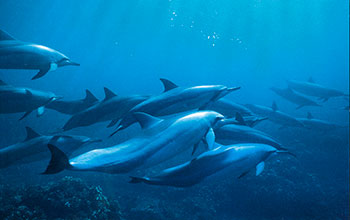Multimedia Gallery
Spinner Dolphins
A school of spinner dolphins. Using state-of-the-art sonar technology, oceanographers have found that spinner dolphins use a highly coordinated technique to herd their prey. This cooperative foraging allows the dolphins to increase the density of the fish they eat by as much as 200 times.
More about this Image
Kelly Benoit-Bird, a researcher from Oregon State University's College of Oceanographic and Atmospheric Science and her colleagues have found that dolphins forage cooperatively at night in groups of 16 to 28. (Their prey comes close to the surface only at night; dolphins cannot dive deeply because of their need for air.) Using precise coordination in strict patterns, the dolphins first swim in a line, pushing the fish forward like a snowplow. Then they circle the fish, and pairs of dolphins take turns feeding inside the circle.
Spinner dolphins, although about half the weight of the familiar bottlenose dolphins, are large predators and have high energy needs. Their name is derived from their ability to leap out of the water and spin as many as seven times before plunging back into the sea. Their complex hunting tactics allow them to survive.
Benoit-Bird is developing new acoustic techniques to measure aggregations of fish. More than 50 percent of fish species are known to be gregarious at some point in their life cycle. Despite the importance of understanding fish shoals (social groups) and schools (synchronized swimming groups), quantitative analyses of gregarious movement behaviors are rare. [This research was supported by a National Science Foundation grant from the Division of Integrative Organismal Systems (IOS 02-05752).] (Date of Image: 2002)
Credit: Andre Seale, University of Hawaii
Images and other media in the National Science Foundation Multimedia Gallery are available for use in print and electronic material by NSF employees, members of the media, university staff, teachers and the general public. All media in the gallery are intended for personal, educational and nonprofit/non-commercial use only.
Images credited to the National Science Foundation, a federal agency, are in the public domain. The images were created by employees of the United States Government as part of their official duties or prepared by contractors as "works for hire" for NSF. You may freely use NSF-credited images and, at your discretion, credit NSF with a "Courtesy: National Science Foundation" notation.
Additional information about general usage can be found in Conditions.
Also Available:
Download the high-resolution JPG version of the image. (11.2 MB)
Use your mouse to right-click (Mac users may need to Ctrl-click) the link above and choose the option that will save the file or target to your computer.

